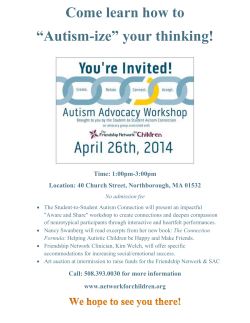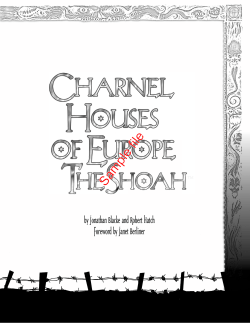
Can Animals be our Friends? 5
5 Can Animals be our Friends? ap ter 1 Pythagoras and the Eternal Self sa m ple ch One of the stories told about Pythagoras is that he rebuked a man who was beating a dog, with the words ‘That’s a friend of mine—I knew him by his voice.’ The story is told to illustrate, maybe to mock, Pythagorean belief in metempsychosis, in the thought that souls migrate into new bodies when their present body dies. It is a belief found all across the world, though not every believer thinks that their soul might end up in a non-human body. I don’t myself think that doctrine is absurd. Standard philosophical arguments against its mere possibility, whether these are Aristotelian or modern materialist, seem to me to beg every question going. That there are theological arguments against its truth, at any rate within the Abrahamic traditions, is a lot more plausible. If we here-now are to hope for the Resurrection, and if God holds persons to be supremely valuable, it does seem that we are destined to be the soul-body composites that we currently are forever.2 My immortal self, so the Christian Councils at any rate have decided, is Stephen, and not the Soul that now animates this person and has animated and will animate however many entities with different names and sensibilities. This may not be the only possible Abrahamic, or even the only possible Christian position: if it’s right, it still isn’t right ‘of necessity’, but only what the [1] An earlier version of this chapter was presented to a colloquium at the University of Chester in September 2007, and published, in brief, as ‘Can Animals be our Friends?’ in Philosophy Now, 67 (May/June 2008), pp. 13–16. See also ‘How Alien are Animals?’ in Pierfrancesco Basile & Leemon B. McHenry (eds.), Consciousness, Reality and Value: essays in honour of T.L.S. Sprigge (Ontos Verlag: Heusenstamm, 2007), pp. 245–58. [2] See Paul Williams, The Unexpected Way: on converting from Buddhism to Catholicism (T & T Clark; London & New York, 2002), pp. 80–83 Can Animals be our Friends? 111 sa m ple ch ap ter Creator has in fact determined. But let this pass: the truth of metempsychosis, though a serious issue, isn’t my concern. I shall also not address the converse, Neo-Cartesian arguments against the possibility of animal consciousness, beliefs, desires and affections. Those arguments depend on the mere assertion that thought and feeling is impossible without a certain sort of language, a doctrine that makes the acquisition of language, by a human infant or the human species, a mere miracle. Oddly, those who deploy the argument in philosophical circles don’t usually acknowledge the theological implications. My experience is that the arguments, and associated specious appeals to Ockam’s Razor, the custom and practice of humankind, and—in appropriate circles—the Bible, seem plausible only to those with a real stake in the conclusion. I shall take it for granted that no likely reader seriously disputes the thesis that vertebrates at any rate have a point of view, are conscious, that there is ‘something it is like to be’ a bat, a cat or crocodile.3 It is probably also common sense to suppose that there is something it is like to be a worm, a wasp or a common octopus.4 But of course it doesn’t immediately follow that their points of view are ours, or that they inhabit anything like the same ‘moral universe’ as we do. After all, plenty of human beings don’t seem to do that either! Pythagoras recognized a friend. Let’s leave it at that, for now. Pythagoras’ heart went out to the dog when he heard his yelps: in that moment, he became a friend. It is not the only possible reaction to an animal’s complaint. A story is told of the Rabbi Judah that when he heard a calf complaining on the way to slaughter, he rebuked him, saying that it was for this that the calf had been created. For this insensitivity he had toothache for thirteen years until one day he saved a weasel’s life, and was pardoned.5 At least Judah gave the calf an answer. The commonest reaction of all, of course, is simply to ignore the noise, which cannot really be a complaint, nor an appeal for justice, nor even a cry for help. Animals, after all, are merely animal. And even those late antique philosophers who lived [3] The expression was first coined by T.L.S. Sprigge, in ‘Final Causes’, Aristotelian Society Supplementary Volume, 45 (1971), pp. 149–70, and used in the context of an interesting argument for panpsychism by Thomas Nagel in ‘What is it like to be a bat?’ Philosophical Review, 83 (1974), pp. 435–50, reprinted in Mortal Questions (Cambridge University Press: Cambridge, 1979). [4] See my ‘Impersonal Minds’ in Anthony O’Hear (ed.), Minds and Persons (Cambridge University Press: Cambridge, 2003), pp. 185–209. [5] Richard H. Schwartz, Judaism and Vegetarianism (Lantern Books: New York, 2001), p. 29, citing Baba Metzia 85a, Midrash Genesis Rabbah 33.3. 112 Understanding Faith out a Neo-Pythagorean or Neo-Platonic tradition mostly made just the same distinction, in order to defend their very un-Pythagorean resort to blood sacrifice. But maybe they were wrong. Common Sense about Friends and Animals sa m ple ch ap ter The context of my present argument is current, Western, common sense. On this view, non-human animals are neither vehicles for just the same sort of soul as human animals, nor are they merely insentient mechanisms. They are animate, sentient creatures, but they are not ‘human’—and neither are they all the same. The sociologist Sherry Turkle can speak of sitting silently, watching children pulling the wings off butterflies, because she supposes that butterflies are ‘far enough from being alive in the way that a person is alive to make its mutilation and killing almost acceptable’.6 I am not sure that a British sociologist could have been quite so indifferent, or so easily persuaded that the children ‘are not simply being thoughtless or cruel’, but merely and commendably playing with their ideas and feelings about life and death. No doubt the children don’t really know what they are doing: it is up to the adults in their life to correct them (and certainly not to refrain because it would be ‘judgemental’ to make any comment). But it is still true that we do commonly make distinctions: I doubt if even Turkle would have been quite so laid back if the children were dismembering vertebrates (and of course the vertebrates would have objected violently, and there would have been more mess). Amongst invertebrates only the common octopus (and not even its closest relatives) is given the same protection as vertebrates by the Animal Procedures Act of 1986. Philosophers working within the mainstream Western tradition often make a simple distinction between human and non-human animals, as though chimpanzees were more like worms than they are like people, but common sense does not agree. We make both objective and subjective distinctions: that is, we divide animals both by their own innate properties and by our own attitudes to them. We treat vertebrates and insects differently because, we suppose, they are innately different. We treat dogs and pigs differently because they mean different things to us, though we recognize that their intelligence and sensitivity are much the same. Friendship, to preempt discussion, involves objective and subjective elements: my friends, perhaps, [6] Sherry Turkle, The Second Self: computers and the human spirit (Simon & Schuster: New York, 1984), pp. 31f: see http://name.umdl.umich.edu/heb01158.0001.001 (consulted 22 April 2006). Can Animals be our Friends? 113 sa m ple ch ap ter share some objective properties, but not all who have those properties are therefore my friends, even if I happen to know them. So my question, can animals be our friends, should really be replaced by a different and much lengthier pair of questions: which animals, if any, can be our friends, and what is friendship? Some animals clearly like our company, and like to be petted—even, so my daughter tells me, giant tortoises. Tradition tells us that even certain insects—namely, bees—cooperate more eagerly with certain humans than with others. Conversely, some humans get on more easily than others with animals of one sort or another. Liking one another’s company and even some physical contact is at least an element in friendship, but probably not the only one. Traditionally, amongst our household pets, dogs may be counted friends, but cats, it is supposed, just like the warmth, the scent, the touch of humans (and of course the food they offer). That this is entirely accurate, I doubt: the distinction is one of human culture rather than objective judgement, and its value is largely that it draws attention to the things we expect of ‘friends’. Feline affection, for example, is not expected to be either faithful, obedient or protective, whereas we take it for granted that dogs will guard and obey us until death. Once again, I am not sure that this distinction is objectively correct: canine fidelity can also be interpreted as the sort of pack loyalty that is easily transformed to rivalry, and cats too sometimes seem both faithful and concerned. But the cats of our ‘imaginary’ are their own masters in ways that dogs are not, and so cannot, we think, be ‘friends’. By Aristotle’s account of friendship, on the other hand, masters and slaves cannot be really friends, since the master does not take any of the slave’s goals as his own: the slave, indeed, has no acknowledged goals, beyond the satisfaction of immediate desires and the release from fear. Natural slaves, in Aristotle’s political ontology, have no conception of doing what is right, nor any chance of a ‘life well-lived’. Still less have any non-humans any share in moral action or in a life well-lived. In actual practice, of course, there may be shared affections, loyalties, and reciprocal obligations even between slave and master, even between man and dog. Since many or most actual slaves are slaves unjustly (not being ‘natural slaves’) the relationship may ascend a step, to the sort of ‘unequal friendships’ in which the merit of the friends so differs that their relationship is feudal rather than egalitarian. Rather than sharing the same advantages of friendship unequal friends get different gains, offer different honour to each other. This may not look like friendship as 114 Understanding Faith sa m ple ch ap ter such at all; Aristotle, after all, was discussing philia, the vital bond of Greek societies that marks off what is ‘one’s own’, a relationship much more ‘political’ than ‘romantic’. But perhaps this is still a useful model, and one we can extend to the non-human. Relationships can be either reciprocal or complementary—a distinction drawn by animal behaviourists who haven’t, probably, read Aristotle.7 It is important to commonsensical tradition that our ‘animal companions’ be inferior in those respects that matter most to us, and acknowledge their subservience—which is another reason why we are uncertain that cats are ever friends. Dogs that too obviously control their households are in need, we suppose, of therapy. Dog-owners who mourn their pets too openly embarrass themselves and others.8 Those who feel more sorrow at their pets’ death than at any human relatives’ decease experience the grief that dare not say its name. Does not their sorrow prove that they had given their hearts to something less than human, preferring mindless affection to the real challenges of human intercourse?9 Their dogs were, in a way, philoi, but the philia was of the unequal kind, and the feudal superior ought not to lose his dignity in grief. Aristotle’s analysis has further advantages. Even among more equal ‘friendships’ there are distinctions. The commonest sort is ‘for pleasure’: philoi who take pleasure together in games, or drink, or even more intellectual pursuits. A second kind of philia is the business partnership, for profit. Only the third kind is counted, by Aristotle, as true philia: the case where philoi recognize each other as good, as just what they themselves would wish and hope to be, as ‘other selves’ for whom it would be proper and even easy to die. Such philoi share a conception of the life well-lived, and value their own virtues expressed more openly in the other. They love each other as themselves. Aristotle held it would be slavish to live ‘for another’, taking the others’ ideals and interests as one’s own, except in just these cases, where philoi take their pleasure, and their profit, in a single noble enterprise. Only human beings can be such philoi, and only what we call ethical human beings, those who do all and only what they conceive is right—which excludes most of us, especially in this [7] R.A. Hinde, ‘Interactions, relationships and social structures’, in Man, 11 (1976), pp. 1–17: p. 7: cited by Barbara B. Smuts, Sex and Friendship in Baboons (Aldine de Gruyter: New York, 1985), p. 61. [8] See Avery D. Weisman, ‘Bereavement and Companion Animals’ in Omega: Journal of Death and Dying, 22 (1990–1), pp. 242–8 [9] See Kennan Ferguson, ‘I © my dog’ in Political Theory, 32 (2004), p. 373f. Can Animals be our Friends? 115 sa m ple ch ap ter hedonistic age. But the other forms of philia have this much in common with the best, that philoi do things together, that they are partners in some enterprise. Inferior partners follow their superiors’ plans. Equal partners are jointly committed to the same endeavour. So what about non-human animals, especially of the sort that human beings domesticate and rule? Of course, by Aristotelian and commonsensical standards, such animals don’t share our plans, except at the level of pleasure, or maybe profit. Human and cat may both have pleasure in the other, even if not the same pleasure. Human and dog may profitably join in hunting or herding, each with their own goals and alert to each other’s profit. But can such partners ever share a conception of what it is right to do, or of a life well-lived? Aristotle’s answer was that they could not—because the notion of ‘what is right, noble, beautiful’ is something only visible to the eye of intellect. Other Platonists—for Aristotle himself was a kind of Platonist—were prepared to suppose that any animate being had some connection with that intellect, even if its eye was, for the moment, blind. They could therefore imagine that non-human animals were sometimes moved by ‘moral beauty’, even if they could not articulate that emotion or that vision. But that possibility is another item that I shall not address—largely because I don’t know how we could settle the question. Instead, it is worth asking whether our contemporary common sense, not being Platonist, has any grounds for saying that animals can’t manage what we manage. If ethics, so to speak is not objective in the way that Platonists believe, what other option have we than to think ‘the good’ is simply what we approve of, what we like and recommend to others whom we like? And non-human animals can have just such sentiments. Different as they are from language-using human beings, they are able to form relationships not only with members of their own species, but also with human beings, while giving expression to their own intentions and purposes. So that the relationships are far more clearly analogous to human relationships than some of the philosophical theorizing that I have discussed would allow. Some human beings indeed and some nonhuman animals pursue their respective goods in company with and in coopera- 116 Understanding Faith tion with each other. And what we mean by ‘goods’ in saying this is precisely the same, whether we are speaking of human or dolphin or gorilla.10 sa m ple ch ap ter Whether or not there is an objective element in ethics, even Platonists can agree that sentiment, and not mathematical reason, is our ground of moral judgement. Our ethics are the ethics of a certain sort of social mammal, programmed to care for our offspring and our immediate kin. In some species that care seems carefully confined: chimpanzees seem wholly indifferent to more distant relatives, feeling no impulse to care for them,11 and even willingly killing members of any rival group (as people also do, but usually needing some rationalized excuse for murder). But this need not be a universal feature. Experiments suggest that other primates will forego advantages rather than cause others pain—and rather more strongly that some scientists won’t. In other species it is even possible for affectionate care to reach out beyond the species—to human observers’ surprise. Recent cases noted in the media include the snake that lives contentedly with the hamster intended for its lunch, or the lioness that persisted in adopting oryxes.12 Young chimpanzees can play with young baboons: maybe some day a pair will maintain that connection into adulthood, uncorrupted by their company. Sociobiologists may believe that this is or would be in some sense ‘an error’, a bit of inheritable behaviour that cannot be really ‘fit’, and so must always be rare. My own guess is that ‘fitness’, in this ethically neutral sense, is not so easy to calculate (on which more below). At the very least, it is obvious that the human capacity for caring for more distant kin, and even for the non-human, has not restricted our reproduction. On the contrary, it is the humans incapable of caring that are rare: we call them psychopaths. There may, sometimes, be small psychopathic populations, but more generous attitudes are as likely to be common. [10] Alastair Macintyre, Dependent Rational Animals (Open Court: Chicago, 1999), p. 61. See further Marc Bekoff, ‘Wild justice and fair play: cooperation, forgiveness, and morality in animals’, Biology and Philosophy, 19 (2004), pp. 489–520. [11] Joan B. Silk, Sarah F. Brosnan, Jennifer Vonk, Joseph Henrich, Daniel J. Povinelli, Amanda S., Susan P. Lambeth, Jenny Mascaro & Steven J. Schapiro, ‘Chimpanzees are indifferent to the welfare of unrelated group members’ Nature, 437 (2005), pp. 1357–9 (http://userwww.service.emory.edu/~sbrosna/ Manuscripts/Silk%20et%20al%20Nature%202005.pdf: accessed 18 April 2006). [12] http://news.bbc.co.uk/2/hi/asia-pacific/4627950.stm; http://news.bbc.co.uk/2/hi/africa/ 1905363. stm Can Animals be our Friends? 117 ap ter So mutually caring companionships are already more than pleasurable associations (the first and commonest form of philia) and more than quid-pro-quo partnerships (the second). They depend on a kind of mutual liking, a recognition of common sentiments and attitudes, that is the sentimental origin of ethics. Primatologists are not entirely wrong to use ‘spatial proximity and grooming as measures of affinity between individuals’, even if they are too quick to include ‘the probability of future copulations’ in their account of what they call friendship.13 It is perhaps notable that adult male baboons are connected most easily to female baboons, of roughly their own age: they don’t have many or any independent same-sex ‘friendships’. ch Female baboons, in general, are wary of males. This is understandable: males sometimes use their larger size and formidable canines to intimidate and bully smaller troop members, Females, however, were apparently drawn to their male Friends, and they seemed surprisingly relaxed around these hulking companions, The males, too, seemed to undergo a subtle transformation when interacting with female Friends. They appeared less tense, more affectionate and more sensitive to the behavior of their partners.14 sa m ple This sort of friendship offers an escape from the normally agonistic and antagonistic nature of baboon—and other primate—society. We aren’t always rivals, or need not be. And generosity goes along with justice: it is possible to feel aggrieved that our associates and almost-friends aren’t ‘playing fair’, and there is evidence that non-humans feel the same.15 On the one hand we are eager to find associates to care for who will also care for us. On the other we are sensitive to betrayals, and united in a desire to see fair play. None of this need be reckoned the result of any rational good will, any deliberate intent to comfort or console or take revenge. I am willing to assume that their behaviour is indeed the product of unreasoned sentiment, and even that these sentiments have been ‘selected’ as being ‘fit’. But it doesn’t follow that just because non-humans cannot deliberately prefer their friends’ welfare to their own that they are therefore to be reckoned merely selfish. Nor does this follow from any post-Darwinian extravagance about the metaphorical selfishness of [13] Smuts, op. cit., p. 38. [14] Smuts, op. cit., p. 61. [15] Sarah F. Brosnan & Franz de Waal, ‘Monkeys reject unequal pay’, Nature 425. 2003, pp. 297–9 (http://www.emory.edu/LIVING_LINKS/capuchins/Brosnan Nature/ Manuscripts/BrosnanUnequalPay.pdf accessed 18 April 2006) 118 Understanding Faith genes. If they cannot distinguish the real good of others from their own comfort in companionship (as we can do) they lie ‘before’ that distinction. What they feel is something that, in us, can sometimes be separated: one of Owen Barfield’s ‘ancient unities’.16 Words and the Wordless ch ap ter I described this as an ‘hedonistic age’, in which it is hard to persuade anyone that much matters more than pleasure or relief from pain. But it is also a strikingly verbal one: it is widely assumed that those who cannot talk can’t really amount to much, even if only a few neo-Cartesians (with whom, you remember, I don’t intend to argue) can bring themselves to believe, and even they half-heartedly, that those who cannot talk don’t think or feel. Traditionalists who wish to defend the rights of the unborn, the infantile, the imbecile or senile, have to insist, in an ancient language, that because they are human, the imbecile and infant must have souls and be deserving of the same respect as rational adults. John Paul II, in Evangelium Vitae, makes the point, in rebuking sa m ple the mentality which tends to equate personal dignity with the capacity for verbal and explicit, or at least perceptible, communication. It is clear that on the basis of these presuppositions there is no place in the world for anyone who, like the unborn or the dying, is a weak element in the social structure, or for anyone who appears completely at the mercy of others and radically dependent on them, and can only communicate through the silent language of a profound sharing of affection.17 But why, even within the older tradition, are the non-human not allowed this silent language? Where did we get the idea that only those in human form have the sort of souls that allow it? Why does even such a civilized theologian as Nicholas Lash unthinkingly contrast ‘human beings’ and ‘things’, as though these classes exhausted the terrestrial universe, saying that ‘there is a difference between listening to a waterfall and listening to another person, and in the natural scientist’s world there are only waterfalls’?18 Even Augustine, who absorbed too much of the Stoic attitude to animals, and was [16] Owen Barfield, Poetic Diction: a study in meaning (Faber: London, 1952, 2nd edn.), pp. 86ff. [17] Evangelium Vitae 25th March 1995 at http://www.vatican. va/holy_father/john_ paul_ii/encyclicals/documents/hf_jp-ii_enc_25031995_evangelium-vitae_en. html, $19. [18] Lash, op. cit., p. 85. Can Animals be our Friends? 119 sa m ple ch ap ter eager to distance himself from his youthful Manichaeanism, acknowledged that many people will understand their dog better than they understand or appreciate a foreigner.19 Our initial experience is often of a household where creatures of several species more or less get along: it is the outsider, the foreigner, even if of our own species, that is suspect. The answer to my historical question is not the one that too many writers still suppose: it was not Biblical Christianity that imposed a radical disjunction between human and non-human, though there are now self-styled ‘Bible Christians’, especially in the States, who seem to think it part of their creed that no-one should care for animals, probably in reaction against what they suppose—not wrongly—to be the implications of evolutionary theory. Nor was it ‘Greek Thought’ that left us in the West this heritage, though—as I have just suggested—there were elements in that tradition that helped create the division. Nor is it reasonable to suggest that we should change things for the better by adopting ‘Non-Western’, Oriental or Amerindian thought patterns (which are as diverse as our own, and often even less animal-friendly). 20 Stoics and Epicureans both rested much of moral law on some form of social contract theory,21 and explicitly excluded those who could make no verbal contracts. Stoics also reckoned that it was only amongst human beings that there could be ‘friends of God’ and co-proprietors of everything, since only humans shared God’s intellectual capacities (it didn’t follow that all human beings could be friends of God, nor that they all deserved respect).22 Platonists, who founded moral law on our intuition of the Good, and its embodiment in the ‘dance of immortal love’, might be expected to have a more animal-friendly outlook, whether or not they believed in metempsychosis. Platonists, including Aristotle, were also open to the recognition that there were no stable or definite boundary lines in nature, and that our formal taxonomies were only a way of thinking. Despite this, we somehow inherited the notion that boundaries [19] Augustine, City of God, Bk. 19, ch. 7. [20] See Rod Preece, Animals and Nature: Cultural Myths, Cultural Realities (University of British Columbia Press: Vancouver, 1999) [21] Though why such contracts should generate moral obligations remains, to me, obscure: brigands may make bargains, of a sort, with others of their gang, but ought they to abide by them? [22] This may be one unfortunate origin of the idea that everything done ‘for the sake of science’ is permitted (which is as much as to say that scientists own everything). At any rate, I can find no other excuse for this delusion! 120 Understanding Faith sa m ple ch ap ter are definite and stable, despite all the obvious counterexamples. Hybridization is either impossible or somehow rather deplorable (I shall address some of the problems this creates for transgenic engineering in a later chapter). Language creates distinctions, and above all the distinction between those who have it and those who don’t. We are then easily persuaded that verbal distinctions correspond to natural kinds—and that we must defend those boundaries. One of Darwin’s most dangerous ideas—not only his, but one that he did much to popularize—is that species are not natural kinds, but only varieties grown just a bit more different, just sufficiently different in fact as to prevent most interbreeding. A species is a reproductively isolated set of interbreeding populations, isolated either by geography or temperament or physiology. Within such isolated super-populations, genetic drift, formal convergence, and even natural selection work their magic, but there need be no species-nature universal among and peculiar to all members of a particular species. This is why ‘speciesism’ does indeed have the same form as ‘racism’, even though species are better defined than races. If we could see the whole collection of individuals belonging over time to the species in which we have an interest, we should see very few, if any, wide disjunctions. S p e c i a t i o n ma y s t i l l b e a G o o d T h i n g , w h e r e a s ‘pseudo-speciation’, whether based on race, class or creed, is not. ‘Without isolation [that is, without speciation] all organic beings would have been nearly uniform, and all would have belonged to a single type, which would be the one best fitted to getting food and for propagating its race: a half-animal, half-vegetable, and a ruthless cannibal.’23 Speciation allows many more creatures to share the world, by diversifying their talents and tastes, and cooperating in the construction of a living world more diversely beautiful, and more stable, than the uniform world imagined by Hutton.24 The price is that everyone has a commitment towards, and sentiment in favour of their own particular species-life and their very own conspecifics. But those commitments and sentiments are not the [23] F.W. Hutton, Darwinism and Lamarkism (Duckworth: London, 1899), p. 105 [24] One of the most striking examples of this is to be found in the cichlid fishes of the African Great Lakes, whose rapid speciation, and concomitant specialization, allows many more organisms a life, each in its own ecological and behavioural niche: see Denis Alexander Creation or Evolution: do we have to choose? (Monarch Books: Oxford, 2008), pp. 98–9. Can Animals be our Friends? 121 ap ter only ones, nor even necessarily the most powerful. Conspecifics, after all, are also our chief rivals and competitors! It may actually be easier to value one’s dog than a stranger: the dog, after all, is a valuable member of one’s household, and whether or not he is a friend he is certainly philos. And for those who like to play sociobiological games, there is no reason why our genes should care which gene-pool they populate. They have as strong an interest, in Dawkins-speak, in their survival outside our species as within. It is true that variants, at least among eukaryotes, mostly spread within a species, but it is not so long since our ancestors were one species: our separation is the relatively recent thing.25 And it has been suggested that it may also be a temporary thing: if technophiliac humanity embraces the full potential of genetic engineering, then the species-barriers are coming down. We shall all recover the prokaryotic mode of life—for bacterial populations are not isolated species-communities even now.26 sa m ple ch Now, after some three billion years, the Darwinian era is over. The epoch of species competition came to an end about 10 thousand years ago when a single species, Homo sapiens, began to dominate and reorganize the biosphere. Since that time, cultural evolution has replaced biological evolution as the driving force of change. Cultural evolution is not Darwinian. Cultures spread by horizontal transfer of ideas more than by genetic inheritance. Cultural evolution is running a thousand times faster than Darwinian evolution, taking us into a new era of cultural interdependence that we call globalization. And now, in the last 30 years, Homo sapiens has revived the ancient pre-Darwinian practice of horizontal gene transfer, moving genes easily from microbes to plants and animals, blurring the boundaries between species. We are moving rapidly into the post-Darwinian era, when species will no longer exist, and the evolution of life will again be communal.27 [25] And it is clear that our isolation, even now, is not complete: viral infection spreads genes across species boundaries: Alexander, op. cit., p. 118 describes the viral population as ‘a giant gene production factory, generating a constant stream of new information, some of which is taken up and adapted for use by other genomes’. [26] Some of this material is also addressed in ‘Elves, Hobbits, Trolls and Talking Beasts’, in Celia Deane-Drummond & David Clough (eds.), Creaturely Theology (SCM Press: London, forthcoming). [27] Freeman Dyson, ‘The Darwinian Interlude’ in Technology Review March 2005, at http:// www.technologyreview.com/read_article.aspx?id=14236&ch=biotech, after Carl Woese, ‘A New Biology for a New Century’ in Microbiology and Molecular Biology Reviews, June 2004. In another sense, it is worth noting, it is only 122 Understanding Faith sa m ple ch ap ter Dyson does not draw any particular morals for our present situation, though he sketches a future in which home biotech packs are readily available: ‘There will be do-it-yourself kits for gardeners who will use genetic engineering to breed new varieties of roses and orchids. Also kits for lovers of pigeons and parrots and lizards and snakes, to breed new varieties of pets. Breeders of dogs and cats will have their kits too.’28 Modern thought has drifted far from the metaphysical and biological theories that, once upon a time, validated the conviction that non-human creatures were all so different from ‘us’ that we could not possibly be ‘friends’. Each of us, human or non-human, is the product of a set of genes almost all of which are widely shared between species: there are probably no specifically human genes, no genes that belong only and entirely within ‘the human genome’, and no specifically human patterns of behaviour. There is a risk that we shall slide into a future where individual self-hood is forgotten, where the world-hive generates whatever mobile units, with whatever functions, that it temporarily desires. One thing that may preserve us from this future is the memory of friendship, the memory, that is, that individual creatures matter, that a soul is worth the saving. Chesterton could think, or at any rate conjecture, that it was only human souls worth this, and that any attempt to equate human and non-human led only to the inhuman. But he also suggested, ‘for those who like such biological fancies, … that we stand as chiefs and champions of a whole section of nature, princes of the house whose cognisance is the backbone, standing for the milk of the individual mother and the courage of the wandering cub, representing the pathetic chivalry of the dog, the humour and perversity of cats, the affection of the tranquil horse, the loneliness of the lion.’29 Those who suppose that animals cannot be our friends do so because they doubt that animals are ever real individuals, whose the vast and rapidly breeding bacterial and viral population that evolves at a molecular level by the strictly Darwinian means of random variation, and differential reproduction of those variations. In multicellular and especially bisexual organisms things get much more complicated very quickly. [28] Freeman Dyson, ‘The Future of Evolution’, ‘originally a talk for fiftieth anniversary of the death of Teilhard de Chardin at Marist College, Poughkeepsie, 14 May, 2005’, published by Metanexus Institute 13 October 2005 http://www.metanexus.net/metanexus_ online /show_article2.asp?id=9361 (accessed 26 April 2006). This paper incorporates material from the one in Technology Review. [29] Chesterton, What’s Wrong op. cit., p. 263f. Can Animals be our Friends? 123 sa m ple ch ap ter soul is worth the saving. Animals are to be valued, if at all, entirely for the good they do us. On this account, it is not unreasonable, though it may well be utterly impractical, to require cloned copies of dead pets. Those who more truly loved their non-human companions would no more desire this outcome than a lover would be pleased by the substitution of his beloved’s twin, or a well-designed replica. In friendship we encounter an individual, not a type, and don’t transfer our loyalties so quickly. This study involves a triangular affair. In one corner are the traditionalists, maintaining with whatever excuse or metaphysical conviction, that non-human and human animals are ‘ships that pass in the night’, whose interests and ideas are entirely opaque to each other. ‘A turkey [for example] is more occult and awful than all the angels and archangels.’30 Any friendship that may seem to exist between such different entities can only be superficial, a mere liking for the other’s physical presence. And though Chesterton insisted that we should respect these other, inscrutable creatures, the practical effect of the doctrine is to endorse most of our existing, exploitative, destructive practices. In the second corner are the modernists, for whom species boundaries are temporary and easily subvertible, and whose metaphysics hardly allow the real existence of individuals at all (though they may retain some superstitions on the subject). The practical effect is very much what Chesterton feared: the transformation of persons as well as animals into tools. And in the third corner are those, like myself, who acknowledge that species makes little difference, but wish to insist on the reality of those we love or might love. Homo sapiens is a species: Humanity is an ideal. Stratford Caldecott has summarized the thought of Hans Urs von Balthasar as follows.31 As a natural faculty, even before it is ‘supernaturalized’ by the indwelling of God’s Holy Spirit at baptism, the spiritual intellect or apex mentis is the organ of metaphysics. It is recognized in all religious traditions, and the knowledge of universals which it gives (however distorted and confused after the Fall) is part of the common heritage of humanity. This is the faculty which perceives all things as symbolic in their very nature; that is, as expressing the attributes of God. Thus Hans Urs von Balthasar writes: ‘The whole world of images that surrounds us is a single [30] G.K. Chesterton, All Things Considered (Methuen & Co: London, 1908), p. 220 [31] Stratford Caldecott, ‘Liturgy and Trinity: Towards an Anthropology of the Liturgy’: http: //www.tcrnews2.com/caldecott.html (accessed 4/4/2006) 124 Understanding Faith field of significations. Every flower we see is an expression, every landscape has its significance, every human or animal face speaks its wordless language. It would be utterly futile to attempt a transposition of this language into concepts…. This expressive language is addressed primarily, not to conceptual thought, but to the kind of intelligence that perceptively reads the gestalt of things.’ ple ch ap ter Whatever name we give it (‘intellect’, ‘imagination’ or ‘heart’), what Balthasar has in mind here is a faculty that transcends yet at the same time unifies feeling and thought, body and soul, sensation and rationality. It is the kind of intelligence that sees the meaning in things, that reads them as symbols—symbols, not of something else, but of themselves as they stand in God. Thus in the spiritual intelligence of man, being is unveiled in its true nature as a gift bearing within it the love of the Giver. Ultimately things—just as truly as persons—can be truly known only through love. In other words, a thing can be known only when it draws us out of ourselves, when we grasp it in its otherness from ourselves, in the meaning which it possesses as beauty, uniting truth and goodness. This kind of knowledge is justly called sobria ebrietas (‘drunken’ sobriety) because it is ecstatic, rapturous, although at the same time measured, ordered, dignified. It is an encounter with the Other which takes the heart out of itself and places it in another centre, which is ultimately the very centre of being, where all things are received from God. sa m We know things truly only through love, and love is a recognition of something Other, something single. Animals become our friends, we become their friends, when they look back at us, and we are confronted by the mystery of the Other which is at the root also of our own being. Suddenly, we realize that they are alive.32 They are not to be respected merely because they are rather like us, but because in many respects they aren’t. Non-humans aren’t, in human terms, as clever as we are, but neither are we, in their terms, as clever as they are. Language is not all important, and the boundaries it creates are there to be transcended. We can ‘communicate through the silent language of a profound sharing of affection’. Pythagoras heard his friend, and knew him by his voice. [32] I do not deny that this realization may sometimes horrify us: that horror is one reason why atheism is sometimes attractive. But it is open to us, along with Plotinus, to welcome the reality: ‘beautifulness is reality’ (Ennead, I.6 [1].6, 21), and the proper response is awe.
© Copyright 2025















